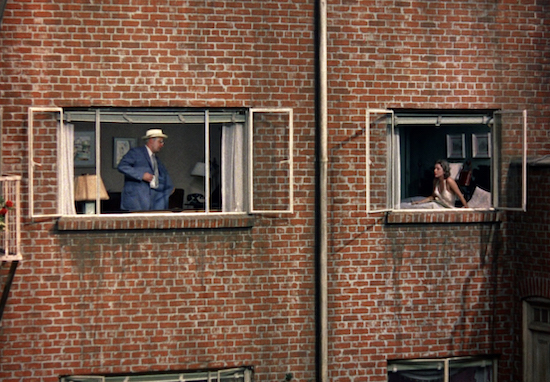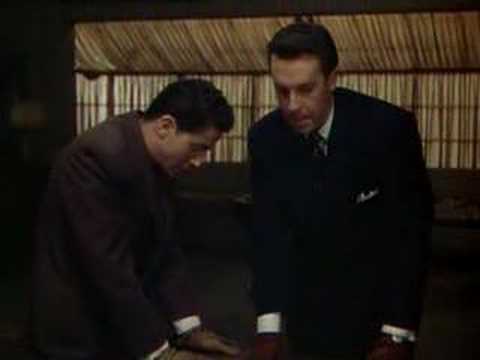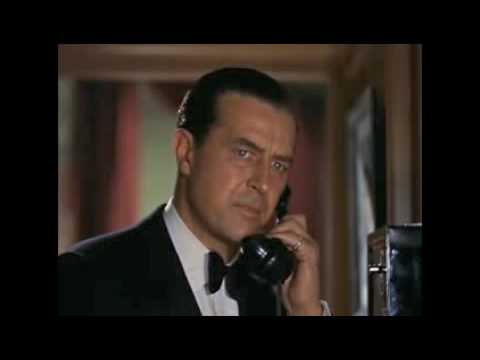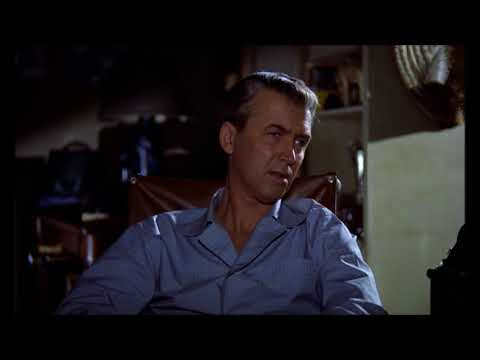A man is trapped indoors. He’s been there for longer than is comfortable, his natural place being out in the wild photographing dangerous news stories. He’s grouchy because of this, spurning advances from his on-off socialite partner and moaning to the visiting physiotherapist who helps with his recovery. A window becomes his portal to the world, and he stares through it with curiosity until something slight catches his eye. Where has his neighbour’s wife disappeared to? Soon the isolation in his flat is more than just a mere annoyance; it is a voyeuristic prison in which the zoom lens of his camera reveals the darker side of the neighbourhood he lives in. Has the confinement made him paranoid or is something more gruesome being slowly revealed through his endless, forced gaze?
This is a rough summation of Alfred Hitchcock’s classic 1954 drama Rear Window. Though the director was infamous for creating some of the most effective moments of tension in cinema, this has often been seen through the use of wider, more encompassing locations. We might immediately think of Cary Grant running in deserted fields in North by Northwest or Robert Donat escaping through mountainous regions of Scotland in The 39 Steps. Yet the director understood more than most the tension that is equally palpable in isolation and enclosed spaces, making some of his work incredibly fitting for our current crisis of social isolation indoors – James Stewart gazing out of the window in boredom in Rear Window, Anthony Perkins staring through a peephole in his lonely motel in Psycho, and two men strangling another in a stuffy flat in Rope. If any director understood the unnerving power of enclosure, whether on screen or implied off screen, it was Hitchcock.
Perhaps ironically, I find something cathartic in watching these films when experiencing a similar confinement. Though only a handful of his narratives have a fully enveloping sense of claustrophobic isolation – namely Lifeboat (1944), Rope (1948), Dial M for Murder (1954) and Rear Window – it feels as if the director is playing to his strengths when his characters are stuck in a situation that limits their movement. In some ways, isolation indoors (or at least some semblance of finite space as in Lifeboat) taps into Hitchcock’s self-confessed fear: the administration of incarceration by the authorities. “I’m not against the police,” he once said, “I’m just afraid of them.”
The fear of isolation and what it does to the psyche arguably stems from an incident in Hitchcock’s childhood, when the six-year-old’s father sent him to the local police station with a note. After reading it, the officer locked the young Hitchcock in a cell with no explanation. It’s not difficult to imagine the few minutes ticking by like years, accelerated horrifically by a child’s imagination to weeks, months and years between the four brick walls of the cell.
In channelling this childhood trauma, Hitchcock found much drama within confined spaces, even when his films were not directly reliant on them. In the films that do restrict the characters and the viewer to a similar confinement, however, a more thrilling tension is created. In Rear Window, one of the director’s strongest films, this is palpable and deeply unnerving. Confinement turns James Stewart’s character into a voyeur of sorts, albeit one who is searching for his more typical journalistic highs via the view onto the neighbouring flats. Having created a unique set in which the whole film unfolds, Hitchcock locks the viewer into the flat too, meaning everything we see is uniquely from behind its window. We are confined within, and whatever menace Stewart’s character unveils will have only one destination in order to try and evade justice: the flat that we, and he, are watching from.
Rear Window was by no means the first time Hitchcock made the most of this effect, and it arguably came from a theatrical as opposed to a cinematic background. The restricted space first comes in a slightly different form in Hitchcock’s controversial Lifeboat, a wartime narrative that sees a ramshackle crew of survivors stuck at sea waiting to be rescued. The tone and feel is slightly different to being confined indoors, if only because the surrounding sea does offer more typical dramatic potential, whether in the form of storms or German U-boats. Instead, Hitchcock really came into his own four years later through the film adaptation of Patrick Hamilton’s disturbing play Rope.
Though the confinement is drawn directly from being performed within the natural limitations of a theatre stage, there’s something within Hitchcock’s film adaptation of Rope that feels even more stuffy and claustrophobic. Rope is very much a macabre parlour game played by its two sadistic lead characters, Brandon (John Dall) and Phillip (Farley Granger). They have murdered a young man, hidden him in the centrepiece of the room and invited his various friends and family to an evening get together to eat off the large cabinet which holds the strangled body of their beloved. Hitchcock learned that pathos was more effective when the viewer was confined within the same space as the unaware characters. By stealthily cutting so that Rope feels as if it is shot in one take and evolving in real time, the illusion of isolation with the characters is complete, rendering the knowledge of what has happened all the more disturbing. It’s as if Hitchcock invited us to the party too, only we know the horror that lies beneath the jovialities. And yet, still, we cannot leave.
What’s interesting about these stories of confinement is that very rarely do they reflect authority’s potential to lock you up, merely that of unfortunate circumstances. Hitchcock’s fear was mixed with being falsely accused, resulting in films following characters on the run from the mechanisms of law which, once grinding away, seem unstoppable even when a man is innocent. Often, characters are fleeing from a potential future confinement in prison as much as from the individuals seeking to enact such justice (and the handful of villains wishing to have their secrets remain untouched). The isolation between four walls instead finds a more unusually accidental flavour, a sort of chance malice that puts a handful of individuals in a tense situation. At the time of writing, in week six of the lockdown due to the coronavirus pandemic, this feels incredibly potent as a dramatic form, if only because the isolation feels unnervingly shared between real and fictional worlds.
In Dial M for Murder, the pressure of confinement is also used to build tension but adds a trickier element to its simple narrative, using 3-D to further enhance the sense of entrapment in the film’s main room. It’s effectively a partner piece to Rear Window, a sense of something approaching from which there is no possible escape. Hitchcock makes the most of locking the viewer within the walls of his narrative world, just as the policeman locked him in the cell when he was a child. It is telling that the fragment of scenes outside of the main flat follow the detective of the piece; only the police are allowed out of the main room. The director becomes the most unlikely of authority figures, trapping us within so that he can make his point and tell his (and, in this case, Frederick Knott’s) story.
Not every element of confinement was expressed in Hitchcock’s films with explicit formal qualities stretched over whole films. Indeed, many of his more macabre scenarios use entrapment and social isolation as a way of explaining the demented and unnerving actions that we witness. The whole narrative of Psycho (1960) hinges on the fact that Norman Bates (Anthony Perkins) and his family motel is isolated away from society both morally and physically. He may have more rooms, two whole buildings in fact, but is still essentially a prisoner, initially of his own mother when she was alive and then, more disturbingly, when she is dead and very much within him. Ironically, the film’s final scene of him incarcerated seems a moment of freedom of sorts, though one where freedom is granted by losing his last few scraps of sanity. The same sense of extended isolation (albeit in the larger realm of Manderley House) is present in Hitchcock’s adaptation of Daphne du Maurier’s Rebecca (1940) too, where the feeling of being stuck in is heightened to alarming effects for Joan Fontaine’s character insatiably following her dangerous curiosity about her husband’s previous wife.
In our current crisis, I’m being drawn back to Rear Window out of all of these films. As I catch myself staring out the window wondering when this isolation will end and the emergency will be over, I doubt whether I’ll find myself drawn into some mystery involving the murderous tendencies of a neighbour. Yet I also think back to that film’s ending, and the joy it seems to bring in spite of the macabre discovery that just precedes it. We track through the many rooms of the neighbours and see a contentment of sorts: the composer has finished his music and the lonely woman has found company, the partner of the dancer returns from the army on leave, the sculptor is asleep in her garden and the couple next door are back to arguing. Normality of some sort never felt so welcome.
Most importantly, James Stewart is stuck in again, asleep in his wheelchair and with two legs now cast in fresh plaster instead of one. Grace Kelly is secretly reading her copy of Harper’s Bazaar next to him as he naps. There’s a potent feeling of acceptance in this ending that I find unusually optimistic for Hitchcock, perhaps ultimately because the scene shows something rare in his films: an acceptance of confinement because another itch has been scratched. For a film that often brings me such pleasure, it was surprising to find the scene provides even more joy than usual on a recent viewing. But then I looked out of my own window. I heard the silence of the streets, saw the emptiness of the skies and the unusual business of my neighbours’ windows. I knew why I took such joy from James Stewart sleeping with a smile on his face: it was proof that the world will still turn.





